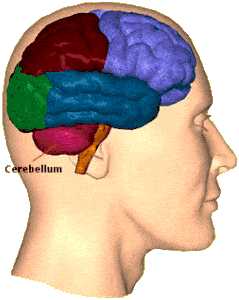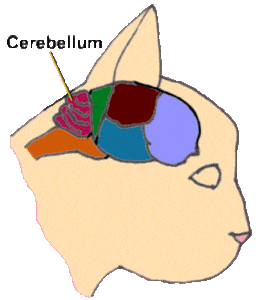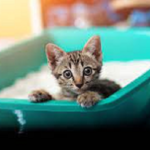A cat with cerebellar hypoplasia is abnormal from infancy, though it may not be clear that something is wrong until the kittens are toddling around with some coordination. The cat with this disease clearly has balance issues: he walks with his legs widely placed for fear of falling and places his feet clumsily.
Your Cerebellum and You

The cerebellum is part of the central nervous system though not exactly part of the brain. It is nestled inside your skull at the base of the brain as shown in this picture. The cerebellum is involved in the involuntary aspects of moving our bodies, whether we are walking around, reaching for something, or just turning our heads. These all seem like voluntary activities so it might be difficult to consider that there is something involuntary going on as well.
Consider walking across an uneven, perhaps rocky, terrain while carrying on a conversation with another person. Certainly the decision to move from point A to point B is voluntary but the chances are you can walk across pretty uneven terrain without falling down or even thinking about where to put your feet. You can thank your cerebellum for that.
Your cerebellum receives information from your feet as well as from the vestibular apparatus in your middle ear. This information tells you where up and down are and where your body is in relation to up and down. Your cerebellum integrates all this information so that you can not only walk or run across uneven terrain without devoting any conscious thought to how to do so, you can turn your head, maybe even drink from a bottle of water, and look at another person while you are walking without (much) chance of falling down.
 Your Cat’s Cerebellum and the Feline Distemper Virus
Your Cat’s Cerebellum and the Feline Distemper Virus
Copyright Dr. Wendy Brooks, used with permission
The cerebellum is obviously a complex piece of equipment. During development before birth, the cerebellum is maturing up until the last few days before birth. Having a long period of development leaves the cerebellum especially vulnerable to an assortment of toxins for a long period of time. In the case of cerebellar hypoplasia the culprit is the feline distemper virus (also called the panleukopenia virus). Growing nerves in the cerebellum are destroyed, ultimately yielding a tiny, improperly developed cerebellum and a disability in the kitten.The mother cat need not be actually infected during pregnancy to create this syndrome; she can simply be vaccinated with a modified live distemper vaccine, the most basic of all cat vaccines. In either case, the kittens are likely to suffer from cerebellar hypoplasia.
Kittens infected with distemper under age 2 weeks may also experience enough cerebellar damage to suffer cerebellar hypoplasia.
This means that mother cats due for vaccines should not be vaccinated during pregnancy or in the first 2 weeks following kitten delivery.
Diagnosis
Feline panleukopenia virus l(the more correct name of feline distemper). Photo courtesy of public domain
While imaging such as CT scanning or MRI can be used to confirm the underdeveloped tiny cerebellum, the diagnosis of this condition is usually obvious because of the following features:
- The condition is non-progressive (it doesn’t get worse).
- The cat is not weak, he’s just not coordinated.
- Intention tremors are evident when the cat is focused but the cat looks largely normal if still.
- Walking is uncoordinated with a wide stance, often using the wall for support.

Feline panleukopenia virus l(the more correct name of feline distemper). Photo courtesy of public domain
The Internet is rife with video shot by owners of CH cats. Here is a video of kittens showing the typical clinical signs, and one of an adult.
Treatment
No treatment can resolve the damage in a kitten with cerebellar hypoplasia. Some kittens are more severely affected than others. Owning a cat with cerebellar hypoplasia emphasizes managing the condition. The cat should be indoors only and non-spill food dishes should be obtained. Most cats have good life quality and make up in personality what they lack in motor skills.
Some on-line communities have sprung up for owners of cats with cerebellar hypoplasia. Some areas that might be of interest
Prevention
This syndrome is easily prevented by vaccinating female cats for feline distemper when they are not pregnant or nursing kittens under age 2 weeks. This means that regular vaccination will prevent cerebellar hypoplasia in kittens. If a cat is pregnant, vaccination should be withheld during pregnancy and for a good three to four weeks after the kittens are born.
Cat Vet Clinic in Houston Heights Area
Urban Animal Veterinary Hospital
1327 Yale St
Houston, TX 77008
(713) 863-008


